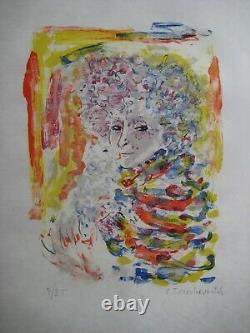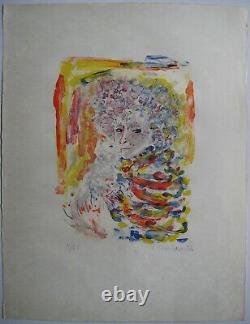
- Index
- Authenticity
- Characteristics
- Genre
- Abstract (96)
- Abstrait (363)
- Art Deco (52)
- Art Déco (109)
- Art Naïf (30)
- Art Nouveau (97)
- Cubism (13)
- Cubisme (26)
- Expressionism (60)
- Expressionnisme (162)
- Fauvisme (13)
- Modern (56)
- Moderne (18)
- Naive Art (21)
- Pop Art (40)
- Street Art (62)
- Streetart (87)
- Surrealism (27)
- Surréalisme (103)
- Symbolisme (14)
- Other (1467)
- Support
- Theme
- Abstract (119)
- Animals (33)
- Architecture (3)
- Art (2)
- Calligraphy (2)
- Character (160)
- Erotic Drawings (3)
- Family (2)
- Fantastic (7)
- Flower, Tree (12)
- Genre Scene (9)
- Landscape (39)
- Music (8)
- Narrative Figuration (2)
- Normandy (3)
- Nude (7)
- Religion, Mythology (7)
- Seascape, Boat (5)
- Sport (2)
- Still Life (8)
- Other (2483)
- Type
Terechkovitch Constantin Signed Lithograph Pencil Numbered/25 Handsigned Lithograph




The Muscat Trellis is the house that the writer Colette had bought near Saint-Tropez. This lithograph illustrates this place. Original lithograph from 1961, signed in pencil and numbered /25 in pencil by the artist. Condition: see photographs; good; never framed; some humidity spots in the margins (see photographs); margins borders are very slightly browned. Paper sizes: 65.5x50.4 cm; image sizes: 40x30 cm. Free hand delivery possible in Paris by appointment. The work is sold with an invoice and a detailed description. Original lithograph produced in 1961, hand-signed and hand-numbered (/25) in pencil by the artist. Conditions: see photographs; good; never framed; some humidity dots in the margins (see photographs); margins borders are very slightly browned. Paper sizes: 65.5x50.4 cm; image sizes: 40x30 cm. Kostia Terechkovitch, also known as Constantin Terechkovitch, born on.
French (naturalized on August 2, 1943) of origin. Jean-Pierre Crespelle describes the family context in which Kostia - diminutive of Constantin - Terechkovitch and his older brother Sevolod were educated: "his parents belonged to this intelligentsia of artists and intellectuals who lived in Russia as in a distant colony, receiving from Europe its ideas and snobberies, its novels and its dresses." His father, a "renowned doctor," runs a mental asylum near Moscow, his mother is the Russian language translator of. Family life is shared between a dacha in the countryside and an apartment in Moscow, both being permanent places of passage for writers and artists where only French is spoken.
From his childhood, Kostia will keep a bright memory of his visits to a close relation of his parents, the very wealthy grain merchant. A big client of avant-garde paint merchants in Paris.
And who, "endowed with great flair, discovered. (he owned twenty canvases) and. Long before French amateurs": The Chtchoukine Palace shaped Kostia's choice to become a painter. In addition to painting, however, and like his brother Sevelod, the record holder of the pole vault in Russia, Kostia Terechkovitch is also a fervent sportsman, which he practiced (he will be the university relay champion in 1917) and which he will keep his passion for throughout his life.
After passing the baccalaureate at the age of fifteen, Kostia Terechkovitch's parents send him to prepare for the fine arts in the workshop of the Moscow painter. "firefighter covered with honors by the tsar and who will succeed in the somersault of finishing the Stalin Prize." He then enters, in a competition where he is ranked third out of five hundred candidates at. Moscow School of Painting, Sculpture and Architecture.In the same year 1917, the. Taking this as an opportunity, he decides to leave for Paris, then the capital of the arts, which he will only reach in 1920 after many adventures and odd jobs, i. "three years of wandering that led him to. Leaving Moscow by joining a service of stretcher bearers responsible for the railway repatriation of German wounded from.
"there were no doctors or medicines on the train, and we could do nothing to save these unfortunate people," Terechkovitch will later recall, who sees them all die for lack of care. It was the most terrible time of my life." , he survives by organizing worker sports clubs in Ukraine, working for a season in a tea plantation in. In the "descent into hell" of sealing coal in the holds of a Greek cargo ship between.
Then working as a stable boy in the British army occupying Constantinople. There he learns about horses, a passion he will later live on the racecourses and that his painting will reflect. A stowaway on a boat leaving for. On board he lives again in the harshness and black dust of the coal hold, then a docker in Marseille, Terechkovitch disembarks in. In Paris on August 2, 1920.
There, after three days of wandering, a Russian Jew to whom he confides his odyssey welcomes him, finds him a maid's room located. And a job in a shoe polish factory. The third month, the significant sum of six hundred francs earned on a lucky Sunday at the.
Allows him to resign to dedicate himself to studying the masters of. And visiting galleries; the fourth month, another lucky chance makes him meet. A fellow traveler, who reveals to him the existence of. ("all the painters are there," says Volovick) where, that same evening, at. He sees among others, among the entire Russian community that he will quickly find again in the neighborhood.The six hundred francs from Chantilly allow him to live the life of an artist, still refraining from painting due to the high cost of colors, but frequenting, to execute drawings that, in order to encourage him. Will buy for one franc each, the. Académie de la Grande Chaumière.
Although there is no teacher, it is in the second place that he regularly meets. Whom he admires and to whom he shows his work.
Kostia Terechkovitch befriends Moïse Kisling. And especially Chaïm Soutine who becomes his great advisor and with whom he begins twenty years of mutual esteem, tensions and reconciliations: "Soutine was my friend," Terchkovitch will confide to Jean-Pierre Crespelle, "but I was not his: with his strange character, he could not have friends... The man was impossible, but I adored his painting... lending me money, he did not want to think about it. He preferred to introduce me to the merchants and he demanded from.
Who swore only by him, to take some of my paintings. Also, on his insistence, he took some paintings from me." While also doing sports at Racing, he maintains a physical form that will allow him to engage for a while as a model, like his friend Volovick, with the Argentine sculptor Lagosse, where he is housed, fed, and receives twenty francs per session. Back to precariousness with the departure of Lagosse in. Going with his suitcase every evening to the Dôme or to.
In search of a charitable soul able to host him, his career begins in 1921 when the essayist writer and art critic Serge Romoff takes him under his wing and offers him a pension of eighty francs per month to allow him to paint, then to have a space of his own, an old abandoned photographer's studio located in a vacant lot in. And where he will receive the first visits of.And its Russian artistic diaspora. And Isaac Mintchine, he is faced, like his compatriots, with the difficult choice of returning to Russia or returning to Paris.
Not making the mistake of his first patron Serge Romoff, who will make this return to Moscow to find a radical banishment from the. And to die in poverty, Terechkovitch returns to Paris. After signing a contract with the merchant Charles-Auguste Girard who notices his submission at the Autumn Salon of 1925, Kostia Terechkovitch is sent all expenses paid by the latter, who wants landscapes of the South, to. Which he returns, after a stop in. Carrying already completed works (The Avallon Factor), "liberated from a certain. Superficial, constituting more than a promise." The Charles-Auguste Girard Gallery organizes his first solo exhibition in 1927. In 1933, he creates the sets and costumes for the show. He married the same year with Yvette Le Mercier, "young and blonde Norman met during a stay in Évreux" and who will become his main model (The series of Young woman with hat that he will paint from 1936 are "Yvette"). Soon followed by the couple's two daughters, France and Nathalie, "in many family scenes, showing evident happiness over the years." From 1934, he participates in the exhibitions of the Friendship Group with. Kostia Terechkovitch is involved in the. And is demobilized in 1940.
He takes refuge with his family in a house near. Most of the portrait paintings of the artists he admires date from this period, notably from. Whose, an old dream that haunted him, he meets at. Settling in a pavilion in the. Terechkovitch travels, is interested in all major sports competitions, especially horse races and.
(which he will attend every four years around the world). And settles for some time in. He is appointed a knight of the. The themes of maturity for Kostia Terechkovitch will mainly be his family and his two daughters France and Nathalie, after having painted many dancers, landscapes (banks of the Marne, beaches, seashores, countryside and villages).Passionate about sports, he owes us racehorses and equestrian scenes it is his own horse, Antheos, that he paints leading the pack in the painting River Jump, "full of movement and colors," which he hangs in 1957 at the Painters Witnesses of their Time Salon. , but also watercolors on tennis, a sport he practices with. Jacques Busse reports, will write about him: "The palette of this painter, his treatment of color, assert his personality. If he has not been able to surpass himself, at least he has placed himself happily." Kostia Terechkovitch is buried in.
Where he lived part of the year.

